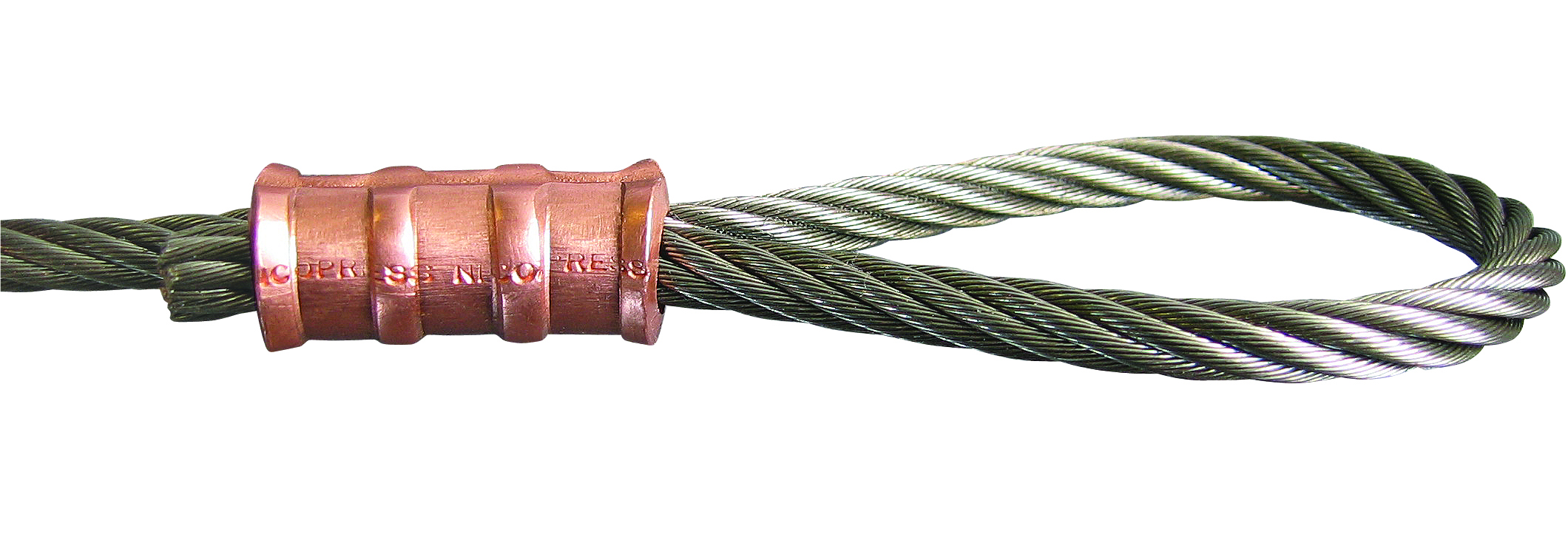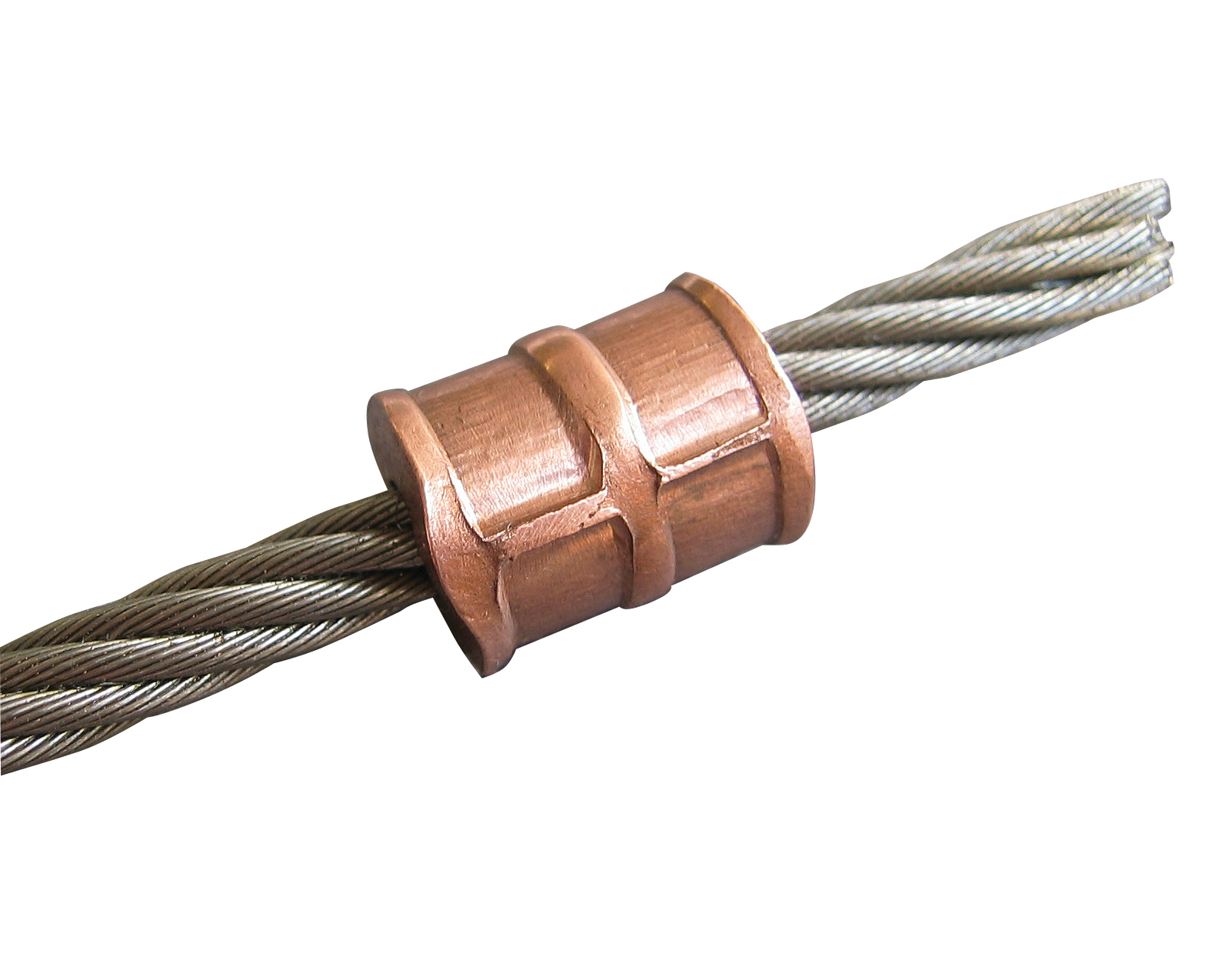|
Swaged Sleeve
A swaged sleeve is a connector that gets crimped using a hand tool and die ( swaged). This type of compressed sleeve is commonly used to make mechanical or conductive connections. These sleeves join or terminate wire rope, aircraft cable, synthetic cable, fibrous rope, or electrical conductor cables. Oval swaged sleeve When properly applied to 7×7, 7×19 or 6×19 IWRC classification wire rope, the eye-splice configuration termination provides a secured connection equal to the breaking strength of the wire rope. The product was originally developed for the US Military, patented in 1942 and currently used in a wide range of applications and industries including: aerospace, defense, marine, material handling, and structural applications. *The product which is used to make an eye splice The eye splice is a method of creating a permanent loop (an "eye") in the end of a rope by means of rope splicing. The Flemish eye is a type of circular loop at the end of a thread. There ar ... [...More Info...] [...Related Items...] OR: [Wikipedia] [Google] [Baidu] |
Swaging
Swaging () is a forging process in which the dimensions of an item are altered using Die (manufacturing), dies into which the item is forced. Swaging is usually a cold working process, but also may be hot working, hot worked. The term swage may apply to the process (verb) or to a die or tool (noun) used in that process. Origin The term "swage" comes from the Old French term , meaning "decorative groove" or "ornamental moulding". Swages were originally tools used by blacksmiths to form metal into various shapes too intricate to make with a hammer alone. These have handles for holding or pegs for attaching to an anvil, and often a flat head for striking with a hammer. Swage blocks are anvil-like dies with various shapes forged into them, which are also used for forming metal. Swages called "fuller (weapon), fullers" are specific to making grooves in swords and knives. ''Swage'' is most often pronounced (The American Heritage Dictionary of the English Language, AHD format: sw ... [...More Info...] [...Related Items...] OR: [Wikipedia] [Google] [Baidu] |
Wire Rope
Steel wire rope (right hand lang lay) Wire rope is composed of as few as two solid, metal wires twisted into a helix that forms a composite ''rope'', in a pattern known as ''laid rope''. Larger diameter wire rope consists of multiple strands of such laid rope in a pattern known as ''cable laid''. Manufactured using an industrial machine known as a strander, the wires are fed through a series of barrels and spun into their final composite orientation. In stricter senses, the term ''wire rope'' refers to a diameter larger than , with smaller gauges designated cable or cords. Initially wrought iron wires were used, but today steel is the main material used for wire ropes. Historically, wire rope evolved from wrought iron chains, which had a record of mechanical failure. While flaws in chain links or solid steel bars can lead to catastrophic failure A catastrophic failure is a sudden and total failure from which recovery is impossible. Catastrophic failures often lead to cascadi ... [...More Info...] [...Related Items...] OR: [Wikipedia] [Google] [Baidu] |
Electrical Conductor
In physics and electrical engineering, a conductor is an object or type of material that allows the flow of charge (electric current) in one or more directions. Materials made of metal are common electrical conductors. The flow of negatively charged electrons generates electric current, positively charged holes, and positive or negative ions in some cases. In order for current to flow within a closed electrical circuit, one charged particle does not need to travel from the component producing the current (the current source) to those consuming it (the loads). Instead, the charged particle simply needs to nudge its neighbor a finite amount, who will nudge ''its'' neighbor, and on and on until a particle is nudged into the consumer, thus powering it. Essentially what is occurring is a long chain of momentum transfer between mobile charge carriers; the Drude model of conduction describes this process more rigorously. This momentum transfer model makes metal an ideal choice f ... [...More Info...] [...Related Items...] OR: [Wikipedia] [Google] [Baidu] |
Nicopress Swaged Sleeve
A swaged sleeve is a connector that gets crimped using a hand tool and die ( swaged). This type of compressed sleeve is commonly used to make mechanical or conductive connections. These sleeves join or terminate wire rope, aircraft cable, synthetic cable, fibrous rope, or electrical conductor In physics and electrical engineering, a conductor is an object or type of material that allows the flow of charge (electric current) in one or more directions. Materials made of metal are common electrical conductors. The flow of negatively c ... cables. Oval swaged sleeve When properly applied to 7×7, 7×19 or 6×19 IWRC classification wire rope, the eye-splice configuration termination provides a secured connection equal to the breaking strength of the wire rope. The product was originally developed for the US Military, patented in 1942 and currently used in a wide range of applications and industries including: aerospace, defense, marine, material handling, and structural applica ... [...More Info...] [...Related Items...] OR: [Wikipedia] [Google] [Baidu] |
Eye Splice
The eye splice is a method of creating a permanent loop (an "eye") in the end of a rope by means of rope splicing. The Flemish eye is a type of circular loop at the end of a thread. There are several techniques of creating the eye with its knot tied back to the line, rope or wire. Techniques There are various splicing techniques, and relate to whether a rope is braided or plaited, whether it has a core and whether the core is made of high-performance fibers. Techniques include: * Eye splice in three-strand rope * Eye splice in eight-strand rope * Eye splice in single braided (hollow braid) rope * Eye splice in double braided rope with polyester or nylon fiber core * Eye splice in rope with braided cover and a laid core * Eyes splice in rope with braided cover and parallel fibers in the core * Eye splice in double braided rope with a high-performance fiber core (e.g. Dyneema, Vectran) In three-strand rope For conventional stranded ropes, the ends of the rope are tuck ... [...More Info...] [...Related Items...] OR: [Wikipedia] [Google] [Baidu] |
Swaged Stop Sleeve
Swaging () is a forging process in which the dimensions of an item are altered using Die (manufacturing), dies into which the item is forced. Swaging is usually a cold working process, but also may be hot working, hot worked. The term swage may apply to the process (verb) or to a die or tool (noun) used in that process. Origin The term "swage" comes from the Old French term , meaning "decorative groove" or "ornamental moulding". Swages were originally tools used by blacksmiths to form metal into various shapes too intricate to make with a hammer alone. These have handles for holding or pegs for attaching to an anvil, and often a flat head for striking with a hammer. Swage blocks are anvil-like dies with various shapes forged into them, which are also used for forming metal. Swages called "fuller (weapon), fullers" are specific to making grooves in swords and knives. ''Swage'' is most often pronounced (The American Heritage Dictionary of the English Language, AHD format: sw ... [...More Info...] [...Related Items...] OR: [Wikipedia] [Google] [Baidu] |
Cables
Cable may refer to: Mechanical * Nautical cable, an assembly of three or more ropes woven against the weave of the ropes, rendering it virtually waterproof * Wire rope, a type of rope that consists of several strands of metal wire laid into a helix ** Arresting cable, part of a system used to rapidly decelerate an aircraft as it lands ** Bowden cable, a mechanical cable for transmitting forces * Rope generally, especially a thick, heavy ("cable laid") variety Transmission * Electrical cable, an assembly of one or more wires which may be insulated, used for transmission of electrical power or signals ** Coaxial cable, an electrical cable comprising an inner conductor surrounded by a flexible, tubular insulating layer, coated or surrounded by a tubular conducting shield ** Power cable, a cable used to transmit electrical power ** Submarine communications cable, a cable laid on the sea bed to carry telecommunication signals between land-based stations * Fiber-optic cable, a cabl ... [...More Info...] [...Related Items...] OR: [Wikipedia] [Google] [Baidu] |
Wire
file:Sample cross-section of high tension power (pylon) line.jpg, Overhead power cabling. The conductor consists of seven strands of steel (centre, high tensile strength), surrounded by four outer layers of aluminium (high conductivity). Sample diameter 40 mm A wire is a flexible, round bar of metal. Wires are commonly formed by drawing (manufacturing), drawing the metal through a hole in a Die (manufacturing), die or draw plate. Wire gauges come in various standard sizes, as expressed in terms of a American wire gauge, gauge number or IEC 60228, cross-sectional area. Wires are used to bear mechanical Structural load, loads, often in the form of wire rope. In electricity and Signal (electronics), telecommunications signals, ''wire'' can refer to electrical cable, which can contain a solid core of a single wire or separate strands in stranded or braided forms. Usually cylinder (geometry), cylindrical in geometry, wire can also be made in square, hexagonal, flattened rectangular, ... [...More Info...] [...Related Items...] OR: [Wikipedia] [Google] [Baidu] |
Fasteners
A fastener (US English) or fastening (UK English) is a hardware device that mechanically joins or affixes two or more objects together. In general, fasteners are used to create non-permanent joints; that is, joints that can be removed or dismantled without damaging the joining components. Steel fasteners are usually made of stainless steel, carbon steel, or alloy steel. Other methods of joining materials, some of which may create permanent joints, include: crimping, welding, soldering, brazing, taping, gluing, cement, or the use of other adhesives. Force may also be used, such as with magnets, vacuum (like suction cups), or even friction (like sticky pads). Some types of woodworking joints make use of separate internal reinforcements, such as dowels or biscuits, which in a sense can be considered fasteners within the scope of the joint system, although on their own they are not general-purpose fasteners. Furniture supplied in flat-pack form often uses cam dowels locke ... [...More Info...] [...Related Items...] OR: [Wikipedia] [Google] [Baidu] |




